#also noticing utena influences in SO MUCH modern media that i’m into
Explore tagged Tumblr posts
Text
finally finished reading "a day of fallen night". absolutely loved it and it’s use of this high fantasy world to explore different views on motherhood without favouring any of them
started watching witch from mercury and revolutionary girl utena
experiencing yuri induced mental illness
#a day of fallen night#witch from mercury#revolutionary girl utena#yeah.. having fun brain full of lesbians#also noticing utena influences in SO MUCH modern media that i’m into#holding off on my time war re-read till i’ve finished rgu. given that both authors are utena fans#me talking
7 notes
·
View notes
Text
Shaman King - Name Games
I didn’t really intend to expand this accidental series of Bleach posts outside one series, but I was looking back at Shaman King, what with the new anime having been announced, and to be honest there’s not a lot to pick at in this particular regard --a lot of the names are pretty straight forward, or just not Japanese, and the O.S. are all similarly named, predominantly in English or with pretty straight forward Japanese epithets.
Like, for example Amidamaru’s name is just written as Amida[阿弥陀] as in the Japanese name for the Buddha, Amitabha, and -maru[丸] super common super generic suffix for boys’ names. All his attack names are accordingly Buddha themed. There’s no real obscure or obtuse kind of references or anything that isn’t really self explanatory. It does tie into Yoh’s general attitude and personal philosophies being zen influenced, which I guess takes a bit of a leap if you’re not familiar, but again it’s pretty obvious.
Then his Over Soul names are all things like:
阿弥陀丸 = “Amidamaru”
スピリット・オブ・ソード = “SUPIRITTO OBU SOODO” = “Spirit of Sword”
...白鵠 = “...Byakko ” = 白:“White,” 鵠:”Swan”
Really straight forward. English readers really weren’t missing much. Or at least if they were reading Mankin Triad’s scanlations. (I’ll be honest, I never read all the Viz prints front to back.)
But you know what are some fun kanji readings that TOTALLY get missed in English? The actual names of the main character. And granted, a lot of characters in the series aren’t Japanese so they don’t all get fun clever names, but the Asakura family is like one big running joke...
So, in-world, the family itself starts in Japan in the 900s with an orphan child named Asaha(麻葉) Douji(童子) whose names read as “Hemp”+”Leaf” and “Child(implicitly a boy)” but also an archaic reading meaning “Scholar" or depending on context “Sorcerer.“

For a little context, despite Japan having rather notorious modern marijuana policing, hemp was actually a widespread and integral crop in Japan for hundreds of years so it’s not an uncommon component of names in the first place. It’s also the basis of a very common pattern in traditional Japanese fabric printing (and you’d probably seen it before in period settings in anime, manga, J-dramas, or film) it’s called Asanoha(麻の葉) and you’ll notice is the exact same kanji as the name Asaha.
The boy, Asaha, grows up to be a powerful onmyoji and changes his name to Asakura(麻倉) Hao(葉王) meaning “Hemp“+”Storehouse/Warehouse/Treasury“ and “Leaf“+”King.” Considering the name “leaf” clearly refers back to the family name’s, “hemp” I really hate to admit it, but Hao’s name is basically “Weed Lord” of the family “Weed Stash.“ If it wasn’t clear this is also why Takei draws a lot of cannabis leaves in association with Yoh(葉) whose name is just written with the same kanji as Hao’s for “Leaf” but with an alternate reading.
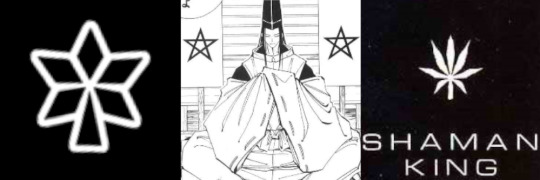
Yoh’s super chill and laid back personality and his ever present headphones for relaxing to are all part of this theme in his name. This theme is also why he’s a fan of Soul Bob (aka totally-not-just-Bob-Marley) and why Soul Bob posters are everywhere in the background of Shaman King. The Asakura family crest, adapted from the Onmyodo five-path star, also resembles a leaf not unintentionally --I don’t remember if they openly refer to that fact in-world or not.
But as we follow the rest of the family tree from there we get the ancestor Yohken(葉賢) from 500 years ago, Yoh’s grandparents Yohmei(葉明) and Kino(木乃), his mother Keiko(茎子) and father Mikihisa(幹久), and eventually his son Hana(花). Also the branch family’s Yohkyo(葉虚), and his kids Ruka(路菓) and Yohane(葉羽). And you’ll probably already notice a lot of those names use the same Yoh/Ha(葉) that is the basis of both Yoh and Hao’s names.
So the rest of the family’s names go...

Yohken(葉賢) = “Leaf”+”Wisdom” which, at face value, is just naming him as a wise shaman. But it’s also basically a cheeky euphemism for “stoner logic.”
Yohmei(葉明) = “Leaf”+”Insight” synonymous with Yohken’s reading.
Kino(木乃) = “Tree”+”From/<posessive indicator>,” so “Hemp Tree” basically
Keiko(茎子) = “Stalk/Stem”+”Child” but keeping in mind that -ko(子) is just a super common suffix for girls’ names, so it’s not like she’s being called explicitly child-like or anything, her name is basically just “Stem Girl”
Mikihisa(幹久) = “Stem”+”Longtime” but I’ll come back to him...
Hana(花) = “Flower” but also a phonetic play on ha(葉) + na(ナ) from his parents’ names
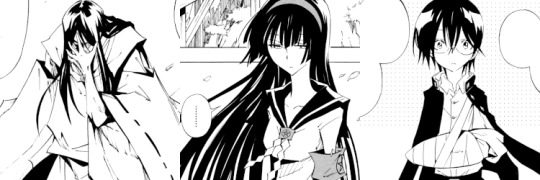
Yohkyo(葉虚) = “Leaf”+”Void/Empty” (haha that’s the same “Hollow” used for Hollows in Bleach) As the head of the disgraced branch family of the Asakura house, his name reflects that he’s not part of the family, despite the family surname, by basically just calling him “No Leaf.” Technically it could also read “Fruitless Leaf” which kinda sticks to the plant imagery better, but makes a little less sense when he has kids...
Ruka(路菓) = “Way/Path/Road” + “Fruit” I assume this is meant as “Way of Fruit” like a metaphor for the fact that she’s been tasked with leading the branch family to success, and not “Road Fruit” as in fruit you’d find on the road, or by the side of the road. Although that does kind of fit in its own way.
Yohane(葉羽) = “Leaf“ + “Feather“ which I think is a play on the fact that when traced back to Jodai era(700s CE) etymology both words shared a common root word, reflecting the fact that he’s got the same ancestor as the core family, but has developed differently but in parallel.

So I said I’d come back to Yoh’s dad, Mikihisa, because as an outsider who married into the Asakura family he has an original family name other than Asakura. His full name is Miki(真木) Mikihisa(幹久) which read as “Truth“+”Tree” and “Trunk/Stem“+”Long Time“ which has some nuance to it. Obviously “Long Time Trunk” and “Tree (of) Truth“ evoke the image of an old and venerable tree with a thick and many ringed trunk. That image plays into Miki’s role as a Shugenja --there is a whole lot going on with the history of the religion, more than I can reasonably summarize, but the thing to know here is that the popular image of Shugenja in media leans into them being ascetic monks, living in the wilderness, generally forest mountains, with an association with Tengu.(Tengu are frequently dressed in Shugendo attire.)
So, the forest man is named after a big tree, pretty straight forward... The clever bit here is how once he takes the Asakura name his name can be read to match his wife’s, as the (幹) in Mikihisa and (茎) in Keiko can both read as “Stem.”
Unrelated to anything, but it’s always super weird to me that English translators insist on calling him “Mickey” (they did the same with Kaoru Miki in Revolutionary Girl Utena....)
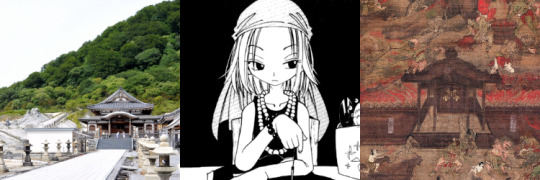
And while I’m talking about outsiders, I’ll bring in Anna as well. Her given name is actually just written in katakana as An’na(アンナ) so, unlike Mikihisa, her name in English is untouched. But her family name Kyoyama (恐山) is written “Fear/Dread/Awe“+”Mountain“ which is both a description of her character as an imposing figure in Yoh’s teen life, but also a reference to Mt.Osore(恐山) where she first meets Yoh, which is both home to a famous Buddhist temple and a mythological location of the gate to the underworld. It is of course written with the same kanji as her family name but pronounced differently, as you can see.
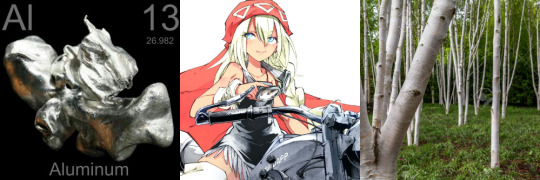
The American, Alumi(アルミ) Numbirch(ニウムバーチ) is obviously named after Aluminum, as all the Patch are named after metals. I’m not really sure why the “-birch” part is in there? It might be an obtuse play on the fact that the Japanese White Birch is also called the Siberian Silver Birch, and her dad is Silva? It feels like a bit of a stretch, but I can’t think of another way “birch” would be relevant to her name. But otherwise she’s not really related to the family theme.
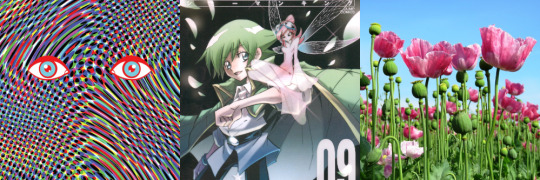
And not at all related to the Asakura’s, but beautiful androgynous British boy detective, Lyserg Diethel is named after the hallucinogenic compound Lysergic acid diethylamide. (aka LSD/Acid) The drug themes is part of why his spirit is named Morphine. She is a nature spirit of (of course) a poppy flower. The other reason she’s named Morphine is because Sherlock Holmes --from whom Lyserg gets his inverness cape aesthetic-- infamously used recreational morphine (and cocaine) to alleviate himself of the lethargy of being without a case to solve.
193 notes
·
View notes